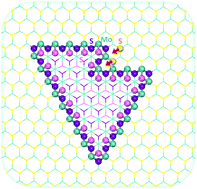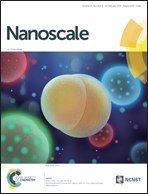Energetics and kinetics of phase transition between a 2H and a 1T MoS2 monolayer—a theoretical study†
Abstract
Phase transitions between semiconducting 2H and metallic 1T (or 1T′) molybdenum disulphides (MoS2) are explored comprehensively by first-principles calculations. The nucleation of a 1T (or 1T′) nucleus in a 2H MoS2 lattice, the formation of the 2H–1T (1T′) interfaces and the kinetics of interface propagation during phase transition were thoroughly investigated in this study. It was found that, among various potential interface structures between the two phases, Mo-rich and two S-rich zigzag (ZZ) boundaries are energetically more preferable than others. Therefore, triangular or hexagonal 1T MoS2 domains with the three types of ZZ boundaries are expected to be the equilibrium structures of the 1T nucleus in a 2H lattice. Further exploration reveals a very high nucleation energy of the 1T phase which suggests that the nucleation may start from a defect site or the edge of the 2H phase. Besides, the kinetics of 2H–1T (1T′) boundary propagation show that the growth rate of the ZZ boundaries is significantly slower than the armchair (AC) ones’. Therefore, the ZZ-boundary dominated domains are expected to be observed during the growth of the 1T phase while the rounded domains with various high-index edges are expected to be seen throughout shrinkage. This study reveals both the energetics and the kinetics of the phase transition of transition metal dichalcogenide materials and also sheds light on other 2D materials.



 Please wait while we load your content...
Please wait while we load your content...